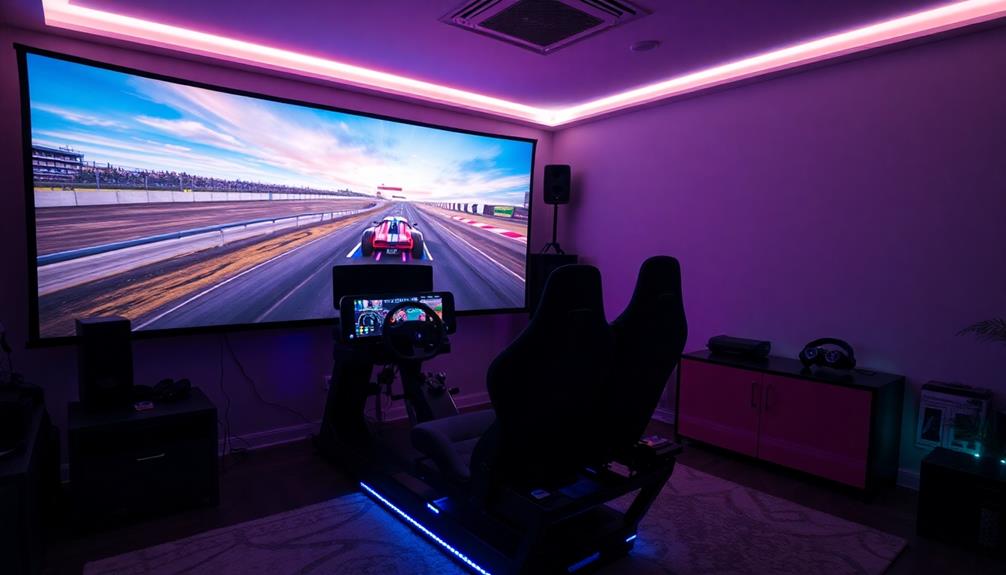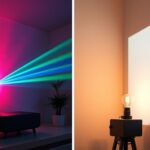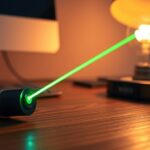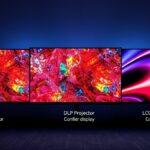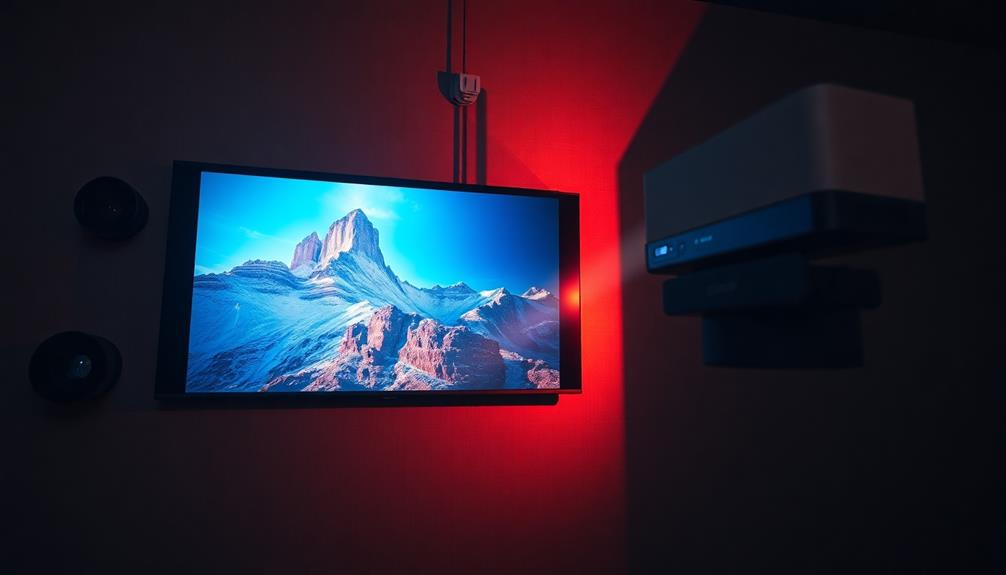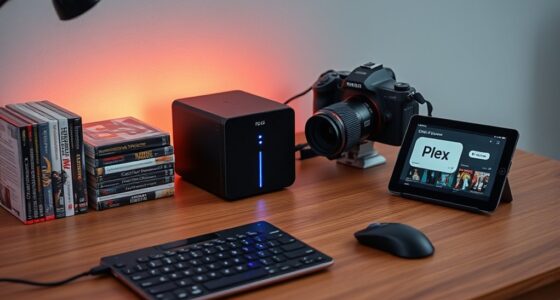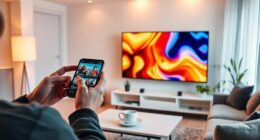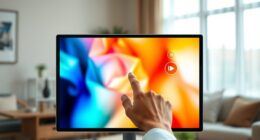When you're comparing lamp, laser, and LED projectors, each has distinct features. Lamp projectors are bright and suitable for large spaces, but they require frequent bulb replacements, leading to higher long-term costs. LED projectors shine in color accuracy and energy efficiency, lasting up to 30,000 hours with minimal maintenance, perfect for controlled environments. Meanwhile, laser projectors outperform in brightness and durability, lasting up to 40,000 hours, making them ideal for well-lit venues. Understanding these differences can help you choose the right projector for your needs, and you may discover even more insights that could guide your decision.
Key Takeaways
- Lamp projectors offer high brightness but require frequent bulb replacements, leading to higher long-term costs.
- LED projectors provide excellent color accuracy, long lifespan, and energy efficiency, making them ideal for controlled environments.
- Laser projectors deliver superior brightness and durability, suitable for large venues, with low maintenance due to sealed optical engines.
- Long-term costs favor LED and laser projectors over lamp projectors, despite the latter's lower initial purchase price.
- Future trends in projector technology focus on increased brightness, energy efficiency, smart features, and environmentally sustainable designs.
Overview of Projector Types

When choosing a projector, which type best suits your needs? Understanding the differences among Lamp Projectors, LED Projectors, and Laser Projectors can help you make an informed decision.
Lamp Projectors use high-intensity electric arcs, offering flexible brightness options but requiring periodic bulb replacements. Their lifespan ranges from 2,000 to 5,000 hours, and they generate considerable heat, which can affect your home theater environment.
LED Projectors, on the other hand, utilize light-emitting diodes, providing an impressive lifespan of 20,000 to 30,000 hours. They're energy-efficient and require minimal maintenance, making them ideal for smaller spaces. However, their brightness levels may not match those of other options.
Laser Projectors leverage laser diodes, achieving lifespans of 30,000 to 40,000 hours. They excel in brightness, color accuracy, and contrast ratios, making them suitable for larger venues or environments with varied lighting.
While they tend to have higher initial costs, their long-term operational costs and lower maintenance make them a valuable investment.
Advantages of LED Projectors
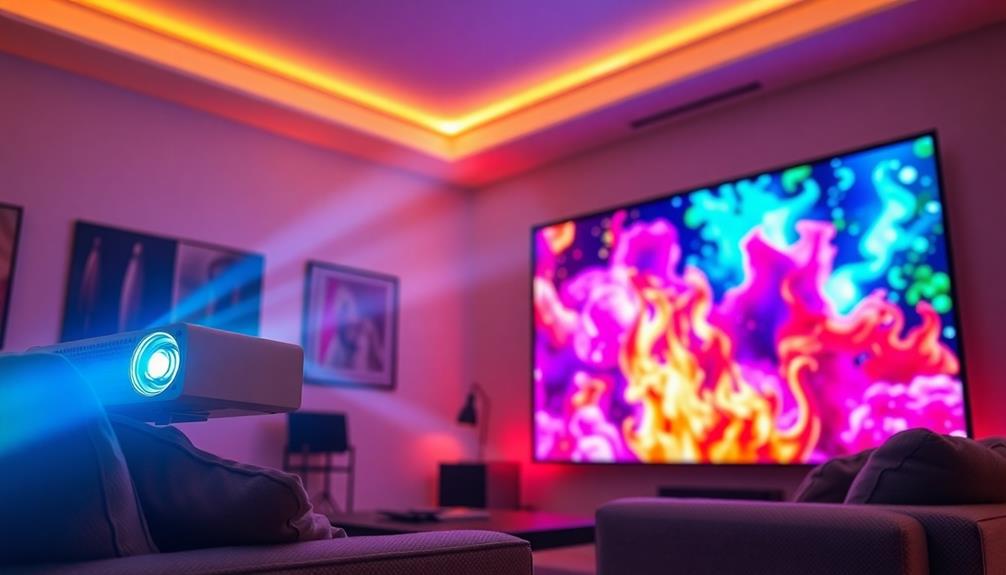
Enjoying the many benefits of LED projectors makes them an attractive choice for various settings. One of the key advantages of LED projectors is their impressive lamp life, lasting around 30,000 hours compared to the 2,000 to 5,000 hours typical of lamp projectors. This longevity results in lower maintenance requirements and long-term cost savings.
Additionally, LED projectors are energy-efficient, converting over 80% of energy into light output. This efficiency not only helps reduce electricity costs but also minimizes your environmental footprint. The color representation provided by LED projectors is exceptional, offering vibrant color reproduction and higher saturation, making them ideal for graphic design and home theaters.
Their compact design allows for easy placement in tight spaces and supports short throw capabilities, enhancing versatility for presentations and home use. Plus, with instant on/off functionality, you can enjoy seamless operation without the warm-up time associated with traditional lamps.
| Feature | LED Projectors | Benefits |
|---|---|---|
| Lamp Life | ~30,000 hours | Less frequent replacements |
| Energy Efficiency | >80% conversion to light | Lower electricity costs |
| Color Representation | High saturation | Ideal for graphics and films |
| Compact Design | Short throw capabilities | Fits in tight spaces |
Benefits of Laser Projectors
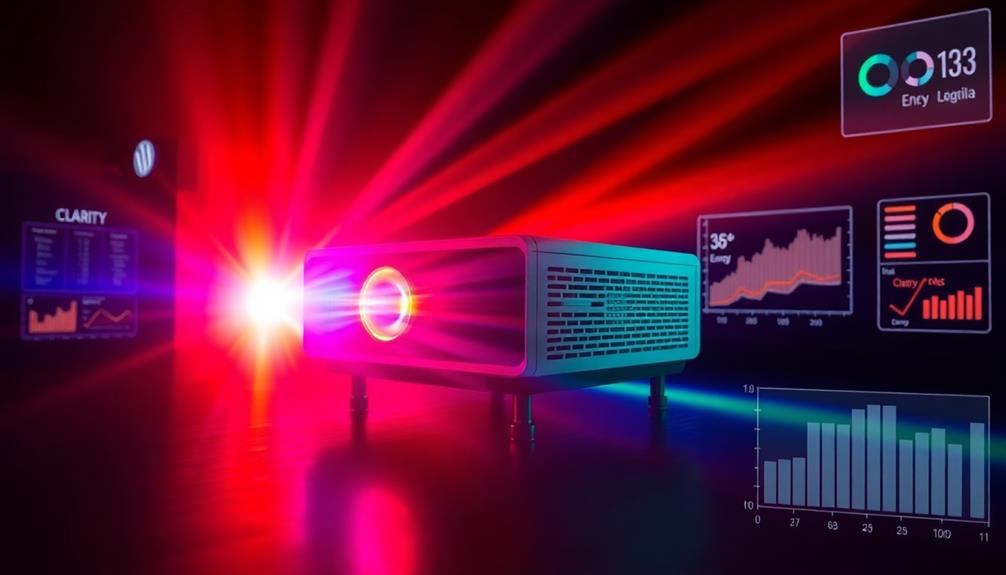
Laser projectors present a powerful alternative to LED projectors, especially for those needing high brightness and durability.
With a lifespan of 20,000 to 40,000 hours, they notably outlast traditional lamp projectors that typically last only 2,000 to 5,000 hours. This extended lifespan not only saves you from frequent replacements but also contributes to lower maintenance needs.
You'll appreciate the superior brightness levels of laser projectors, often exceeding 30,000 lumens, making them perfect for large venues and well-lit environments.
The sealed optical engines protect the internal components from dust, further enhancing their longevity and reducing maintenance efforts.
When it comes to image quality, laser projectors excel with high color accuracy aligned with industry standards like Rec. 709 and DCI-P3.
This guarantees you'll enjoy vibrant, true-to-life images for all your professional presentations.
Plus, the instant on/off capability means you won't waste time waiting for warm-up; you can start your presentations immediately, which is particularly beneficial in business and educational settings.
It's clear that laser projectors offer numerous advantages that can enhance your viewing experience.
Pros and Cons of Lamp Projectors

Many users find lamp projectors to be a cost-effective solution for their presentation needs. They typically come with a lower initial purchase price, making them budget-friendly for casual users.
With brightness levels often exceeding 2,000 ANSI lumens, these projectors can deliver bright images that work well in large spaces.
However, lamp projectors have a lifespan ranging from 2,000 to 5,000 hours, which means you'll need to plan for maintenance and periodic bulb replacements. This necessity can lead to increased long-term costs, especially if you're using the projector frequently.
While they offer good color accuracy when properly calibrated, the brightness can degrade over time, negatively impacting image quality as the lamp ages.
Additionally, lamp projectors generate considerable heat during operation, which may require extra cooling measures to prevent overheating. This heat can be a concern in small or poorly ventilated rooms.
Performance Comparison
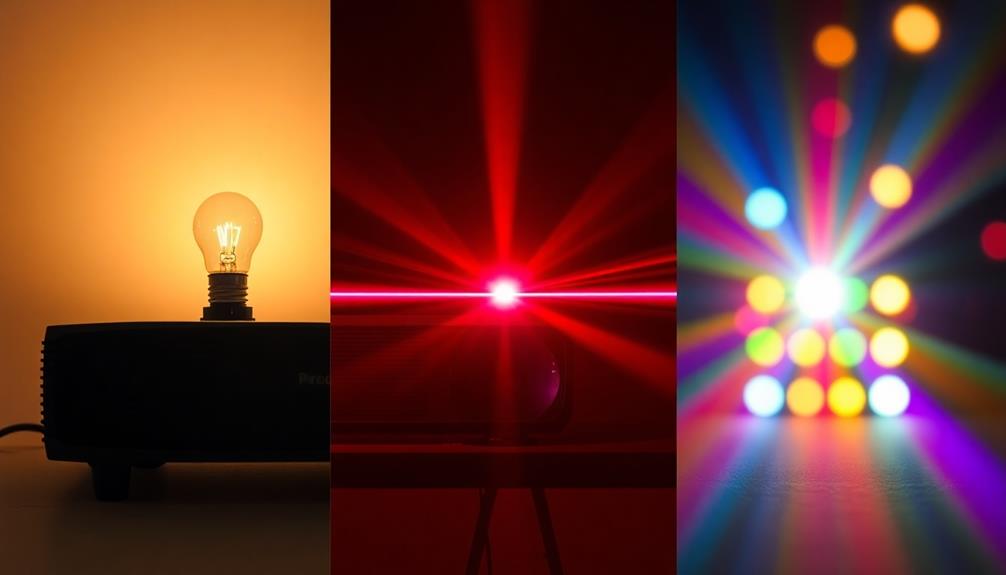
When you compare light source technologies, you'll notice significant differences in color reproduction quality, brightness levels, and overall durability.
Laser projectors shine in brightness but may lag behind LED models in color accuracy.
Understanding these performance metrics can help you choose the right projector for your needs.
Color Reproduction Quality
In today's world of projection technology, color reproduction quality is a critical factor for professionals and enthusiasts alike.
You want your visuals to be vibrant, accurate, and true to life. Here's how different technologies stack up:
- LED Projectors: Offering the highest color accuracy, LED projectors excel in color fidelity and can exceed 125% of the Rec. 709 color gamut. This makes them ideal for applications where precision is necessary.
- Laser Projectors: These projectors deliver saturated and dynamic colors through phosphor excitation, aligning with both Rec. 709 and DCI-P3 standards. They're versatile and maintain good performance in various lighting conditions.
- Lamp Projectors: While they can achieve decent color accuracy when calibrated, lamp projectors often struggle over time.
Their color reproduction quality generally falls short, particularly regarding depth and saturation.
Brightness Levels Comparison
While brightness levels are essential for achieving ideal viewing experiences, different projector technologies exhibit varying capabilities.
Lamp projectors typically deliver brightness levels exceeding 2000 ANSI lumens, making them suitable for well-lit environments and outdoor screenings. If you need high brightness, lamp projectors can perform well, but keep in mind that their brightness can degrade over time due to bulb wear.
On the other hand, LED projectors generally produce brightness levels below 2000 ANSI lumens. They're best suited for controlled lighting conditions, like home theaters, where ambient light can be minimized. If you're in a setting with more light, you might find LED projectors lacking.
Laser projectors stand out with superior brightness, often exceeding 3500 ANSI lumens. This makes them ideal for large venues and brightly lit spaces, offering consistent brightness throughout their lifespan.
For applications requiring high brightness and clarity, laser projectors are your best choice, followed by lamp projectors. If you're looking for a projector that maintains performance over time, consider the consistent brightness of laser and LED projectors, although the latter may not reach the same brightness levels as the former.
Durability and Lifespan
Brightness levels play a significant role in projector performance, but durability and lifespan are equally important factors to contemplate.
When choosing a projector, consider how these aspects can impact your overall experience and costs.
1. Lamp Projectors: Typically last between 2,000 to 5,000 hours, requiring frequent bulb replacements and ongoing maintenance costs.
Their reliance on high-intensity bulbs makes them more prone to failure, which can be frustrating.
2. LED Projectors: With a lifespan of 20,000 to 30,000 hours, LED projectors drastically reduce maintenance needs.
Their solid-state designs enhance durability, meaning you won't have to worry about as many component replacements over time.
3. Laser Projectors: Generally exceed 20,000 hours and can even reach 40,000 hours in some models.
This impressive lifespan translates to lower long-term maintenance requirements compared to lamp projectors, making them a more sustainable choice.
Applications and Use Cases
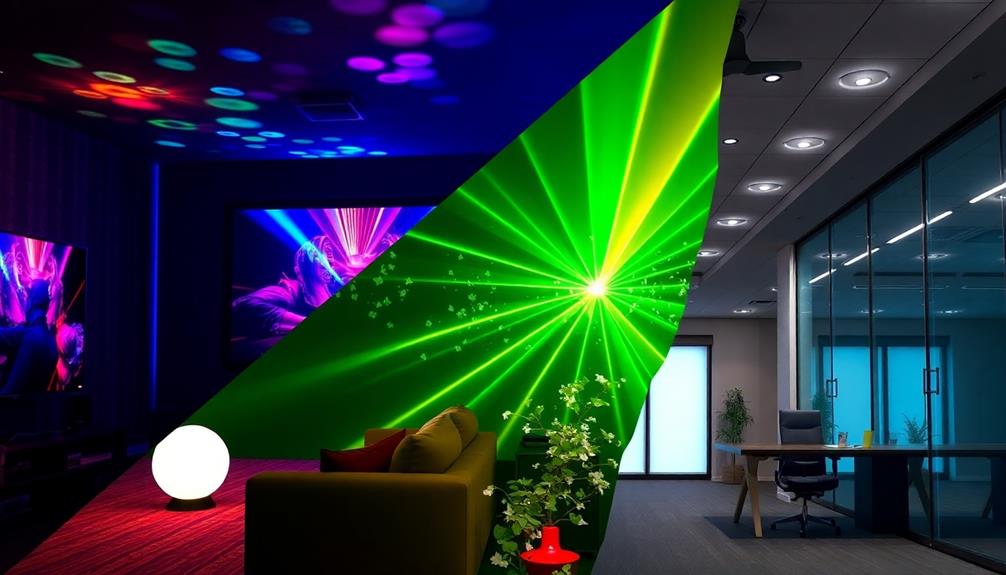
Various light source technologies serve distinct applications, catering to different environments and user needs. When choosing a projector, it is crucial to take into account your specific use cases and the conditions in which you'll be using it.
| Technology | Best Use Cases |
|---|---|
| Lamp-based Projection | Outdoor screenings, large venues |
| LED Projectors | Home theaters, classrooms |
| Laser Projectors | Business presentations, large conferences |
| LED Projectors | Controlled lighting environments |
Lamp-based projection shines in outdoor settings due to its high brightness levels, comfortably overcoming significant ambient light. For home theaters or classrooms, LED projectors excel, offering energy efficiency and a lifespan of around 30,000 hours, thereby minimizing maintenance needs.
On the other hand, laser projectors are your go-to for business presentations and large conferences. They provide high brightness exceeding 3500 ANSI lumens and guarantee superior color accuracy, making visual content sharp and vibrant, even in brightly lit environments.
Maintenance and Energy Efficiency

When you consider maintenance and energy efficiency, it's clear that LED and laser projectors stand out.
With their longer lifespans and reduced maintenance needs, they save you both time and money compared to traditional lamp projectors.
Plus, their energy consumption rates can greatly lower your long-term operational costs.
Maintenance Frequency Comparison
One key aspect to contemplate in the maintenance frequency comparison of projector technologies is how often you'll need to replace the light source. This decision greatly affects your total cost of ownership and long-term operational costs.
Here's a quick comparison of maintenance needs for each technology:
- Lamp Projectors: Expect frequent lamp replacements every 2,000 to 5,000 hours. This leads to higher maintenance needs and costs over time.
- LED Projectors: These have an impressive lifespan of about 20,000 to 30,000 hours, resulting in minimal maintenance needs. Their lower energy consumption also contributes to reduced electricity bills.
- Laser Projectors: With longevity ranging from 20,000 to 40,000 hours, laser projectors offer lower maintenance due to sealed optical systems that limit dust exposure.
The frequent bulb replacements required by lamp projectors can add up quickly, making them less cost-effective compared to LED and laser projectors.
Ultimately, if you prioritize lower maintenance and efficiency, both LED and laser technologies shine brighter in the long run.
Energy Consumption Analysis
In addition to maintenance considerations, energy consumption plays a significant role in evaluating projector technologies. You'll find that energy efficiency varies greatly between LED, laser, and lamp projectors. Here's a quick comparison:
| Projector Type | Energy Efficiency | Lifespan |
|---|---|---|
| LED Projectors | >80% light output | 20,000+ hours |
| Laser Projectors | Moderate | 30,000-40,000 hours |
| Lamp Projectors | Low | 2,000-5,000 hours |
LED projectors stand out as the most energy-efficient option, converting over 80% of energy into light, leading to lower electricity costs. In contrast, lamp projectors have high energy consumption, with frequent bulb replacements inflating maintenance costs. Laser projectors consume more energy than LEDs but provide longevity, reducing operational costs over time.
With minimal maintenance needs, both LED and laser projectors contribute to lower long-term costs and sustainability. They don't require regular lamp changes, which also cuts down on downtime. Overall, considering energy consumption helps you make a more informed choice when investing in light source technologies for your needs.
Long-term Cost Implications
Long-term cost implications play an essential role in choosing the right projector technology for your needs. When considering projectors, it's important to evaluate maintenance and energy efficiency to understand the overall expenses involved.
Here's a breakdown:
- Lamp Projectors: They typically last only 2,000 to 5,000 hours, meaning you'll face frequent bulb replacements. This leads to higher long-term costs due to ongoing maintenance and replacement expenses.
- LED Projectors: Boasting a lifespan of 20,000 to 30,000 hours, LED projectors greatly reduce maintenance costs. Their impressive energy efficiency also translates to lower electricity bills, making them a smart long-term investment.
- Laser Projectors: With a lifespan of 30,000 to 40,000 hours, laser projectors eliminate the need for bulb replacements, which saves you money on maintenance. While they consume more energy than LEDs, they still offer better energy efficiency than traditional lamp projectors.
In the projector market, while lamp projectors may seem cheaper upfront, LED and laser options can be more cost-effective over time due to their lower long-term costs and reduced maintenance needs.
Future Trends in Projector Technology
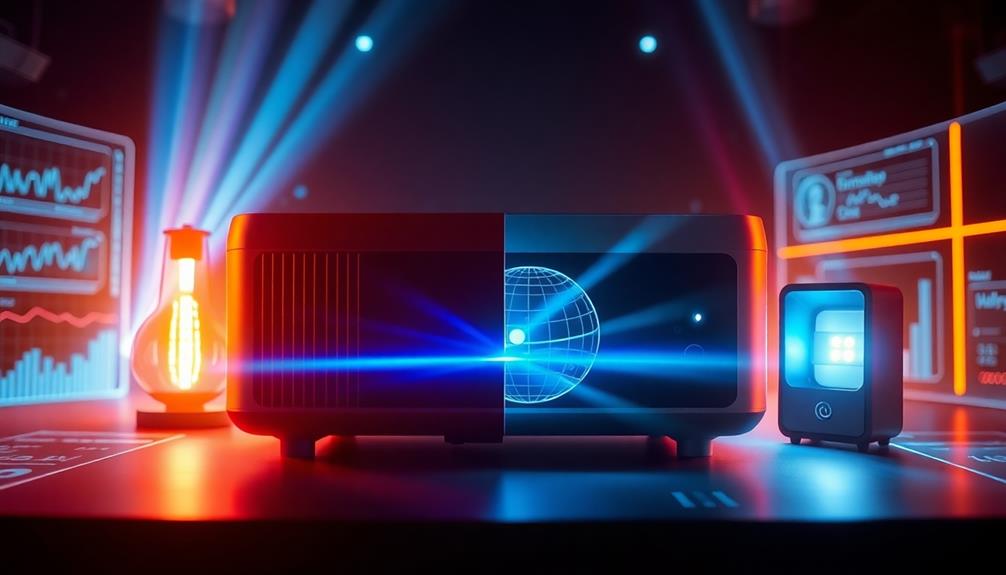
Projector technology is on the brink of a considerable transformation, driven by advancements in LED and laser systems. Future projections indicate that laser projectors require less maintenance and will likely exceed 50,000 ANSI lumens, greatly boosting brightness and color representation. This leap in performance makes them ideal for home theaters and large venues alike.
Additionally, regular maintenance such as projector bulb maintenance can further enhance the longevity of traditional projector models. Meanwhile, LED technology continues to evolve, focusing on increased brightness and efficiency, making these projectors competitive with their laser counterparts.
In addition to performance enhancements, projectors boast smarter features that improve user experience. Expect seamless connectivity and advanced onboard processing capabilities in upcoming models.
Environmental sustainability is also a key driver of change, as both laser light projectors and LED models eliminate the need for toxic mercury disposal and reduce energy consumption.
As the demand for portable projectors grows, manufacturers are prioritizing compact designs that incorporate these advanced technologies, catering to both consumer and professional markets.
You can look forward to more versatile options that deliver high-quality light output in a range of settings, making projector technology more accessible than ever before.
Frequently Asked Questions
Which Is Better Laser or LED Light Source Projector?
When choosing between laser and LED projectors, consider your needs. If you want brighter images and longer lifespan, go for laser. For better color accuracy and energy efficiency, LED might suit you best.
What Is the Best Light Source for a Projector?
When you're seeking the brightest star to illuminate your presentations, consider LED projectors. They offer vibrant colors and longevity, ensuring your visuals shine brilliantly for years, making them a wise choice for your needs.
What Is the Difference Between LED and Projector?
You'll find LED projectors use Light Emitting Diodes, offering longer lifespans and better energy efficiency than traditional projectors. They produce vibrant colors but may struggle in very bright environments compared to other projector types.
Is a Laser Projector Better Than a Regular Projector?
Yes, a laser projector's typically longer lifespan, superior brightness, and enhanced color accuracy make it a better choice for many. You'll enjoy reduced maintenance and improved image quality, ultimately providing a more satisfying viewing experience.
Conclusion
In the world of projectors, choosing the right light source can feel like selecting the perfect wand in a wizard's shop. Each technology—LED, laser, and lamp—offers unique benefits and drawbacks, like characters in your favorite story. Whether you prioritize longevity, brightness, or cost-effectiveness, there's a projector that fits your needs. As you navigate these options, remember that the best choice will light up your presentations and movies like a well-cast spell, transforming your viewing experience.

